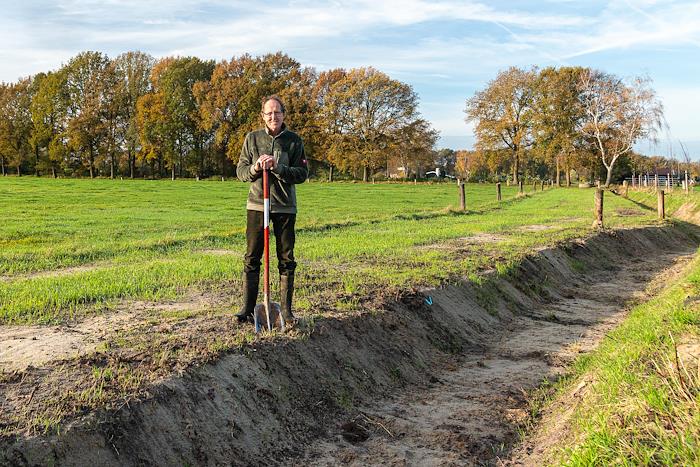In short:
Global Goal

This was not the case for farmer Henk Kiewik and his wife Ine, who own landscape and care farm De Rökker in Lonneker. He harvested the maize that he grew to feed his dairy cows. Nothing withered and dried up; they were nice, green, and full of cobs. How can that be? The ditches on one of his plots have been made shallower, over a length of about a kilometre. "They were about 1.20 deep before, but they are only about 50 centimetres below ground level now", he says. "The water has more time to infiltrate the soil because we used sand to put the drainage out of action. The bearing capacity of the soil was a bit lower as a result, so we could only start sowing a bit later in the year, but it worked out in the end, and we were able to retain more water."
Making the ditches less deep was only one of the options Henk had to retain water. “We could have constructed ditches at different spots on the plot too, but that wasn’t our best option. The Water Board looked at our farm, did a soil analysis in several places and gave us a report with recommendations”, he says. This is part of LTO Netherlands’ Detaplan Agrarisch Waterbeheer (DAW), in which farmers and gardeners work on having clean and sufficient water and better soil. They take measures on their farms voluntarily. The Water Board made a financial contribution to the measures this farmer from Twente took. "It worked out well this year, but the land looked like it was getting too wet last year when we had a 'normal' summer. That was a bit worrying, but even then, it worked out in the end.

Henk’s thoughts regularly go back to when he started farming in the early 1970s, now that his farm has shallow ditches again. "The ditches were about this deep back then; I even drove through them with the tractor sometimes", he recalls. "We started using the land more intensively over the years, so they were deepened, and drainage was installed. We are now going back to how it was before. Less intensive, but still sufficiently profitable."
He makes more ‘green’ choices on his farm. He is switching to herb-rich grass, for instance. Not only because Friesland Campina asks dairy farmers to do so but also to support nature. More diversity in the grass attracts different and more insects. Moreover, this grass can deal with drought better because the roots are deeper. "We have also sown road verges to promote biodiversity, which is good for bees and insects."
According to Henk, many more farmers could take measures to give the climate a helping hand. "Not every farmer realises we can do quite a bit on our own. Every little bit helps limit the damage.”
He concludes with another positive side effect of his shallow ditches. “One of our neighbours created a frog pool in the mid-1990s, but it has been dry every summer. But water has been in it every summer since we worked on our ditches. Good news for the frogs, the other animals, and the greenery around it!”
Date: 23 September 2022 |
Source of tekst: Henk Kiewik |
Author: Maaike Thüss








